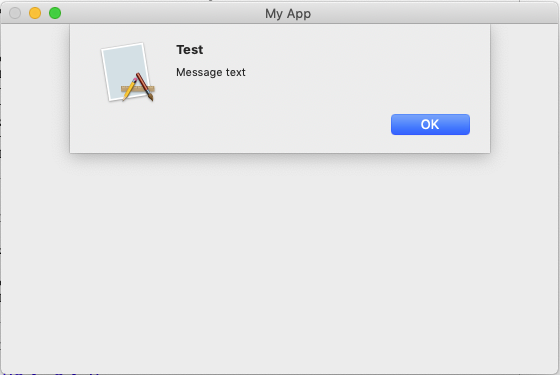Using macOS Sheets
This article applies to macOS only.
See also: Multiplatform Programming Guide
A sheet is a modal dialog that’s attached to a particular window—usually a document—and prevents further interaction with the window until the sheet is dismissed. It is the Apple recommended way to request user input before proceeding with a document-specific action, such as attaching files, exporting, saving, and printing. Sheets are also used to present information to the user before the next step, for example, a licensing agreement that requires acceptance.
According to Apple's Human Interface Guidelines, you should only use a sheet when a window has a frame. Sheets should always emerge from a window’s frame above the body area. Here is an example:
The code below creates the sheet as shown in the above example.
unit unit1;
{$modeswitch objectivec1}
interface
uses
...
MacOSAll, CocoaAll, LCLType,
...
;
type
{ TForm1 }
TForm1 = class(TForm)
...
private
public
end;
var
Form1: TForm1;
implementation
{$R *.lfm}
{ TForm1 }
...
procedure ShowAlertSheet(FormHandle: HWND; const TitleStr, MessageStr: string);
var
tNSStr, mNSStr, okNSStr, fNSStr: NSString;
theWindow : CocoaAll.NSWindow;
theID : id;
begin
theID := NSView(FormHandle).window;
theWindow := NSView(FormHandle).window;
tNSStr := NSString(CFStringCreateWithPascalString(kCFAllocatorDefault, TitleStr, kCFStringEncodingUTF8)); // title
mNSStr := NSString(CFStringCreateWithPascalString(kCFAllocatorDefault, MessageStr, kCFStringEncodingUTF8));// message
okNSStr:= NSString(CFStringCreateWithPascalString(kCFAllocatorDefault, 'OK', kCFStringEncodingUTF8)); // button caption
fNSStr := NSString(CFStringCreateWithPascalString(kCFAllocatorDefault, '%@', kCFStringEncodingUTF8)); // format
NSBeginAlertSheet(tNSStr,okNSStr,nil,nil,theWindow,theID,nil,nil,nil,fNSStr, mNSStr);
end;
...
end.
To call the ShowAlertSheet procedure from, for example, a menu item:
procedure TForm1.MenuItem1Click(Sender: TObject);
begin
ShowAlertSheet(Form1.Handle, 'Test', 'Message text');
end;

